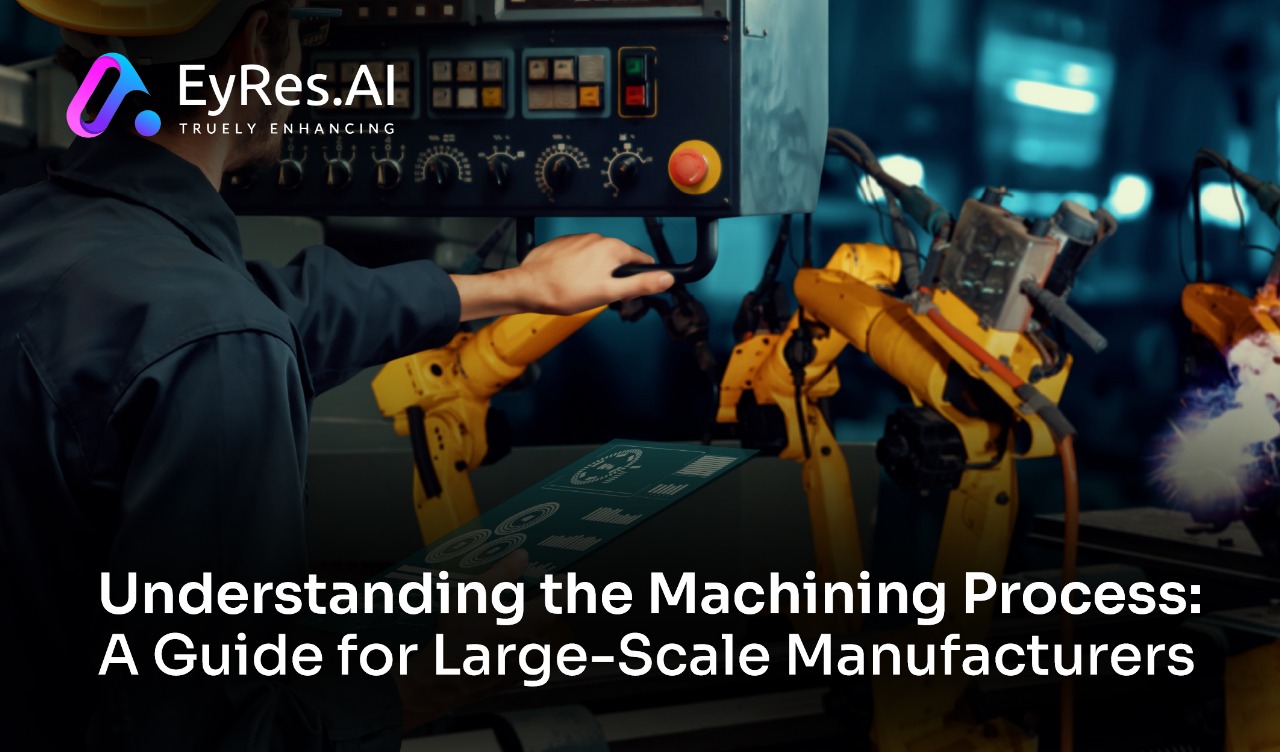In short, machining is a subtractive manufacturing process wherein material is removed to achieve the required geometry, size, and surface finish. It can also be done in a manual mode or an automated mode, especially with this new generation of CNC machines, which are an epitome of accuracy and repeatability. Those companies that use highly accurate parts for production, like the manufacturers of tires, food processing plants, and heavy equipment industries, need machining tools to manufacture parts with little or no error and maximum efficiency. The machining process can be divided into two primary categories: Primary Machining: The first shaping of the raw material. Secondary Machining: This is the process of further manufacture of the component to achieve precision and functionality. Now, let's discuss the following processes in detail. Eyres AI Primary machining is the foundry of manufacturing. It means that the material is either cut, formed, or shaped into a nearness of the final product size. This is an important stage because it gives an initial framework for the refinement of the process in secondary machining. Types of Primary Machining Processes Turning – A lathe removes material from a rotating workpiece. Milling – A milling machine cuts away material using rotary cutters. Drilling – A drill bit creates holes in a material. Sawing – A saw is used to cut raw materials into manageable sizes. For such mass industries like tire making, primary machining plays a crucial role in the developing process of molds and dies used during the rubber processing procedures. In food and beverage industries, precision cutting ensures that the manufacturing equipment works without any glue attached, reducing downtime and waste Secondary Machining: Precision & Finishing Touches After primary machining provides the approximate shape, engineers then move on to secondary machining to have more precise tolerances, finer surface finishes, and functional details. Common Secondary Machining Operations Grinding – Used for fine finishing and achieving high accuracy. Honing – Improves surface texture and dimensional accuracy. Boring – Enlarges holes created during the drilling process. Broaching – Creates complex shapes such as keyways and splines. A secondary machining manufacturer that focuses on large production can improve product quality by smoothening parts to high tolerances. This is more so in food processing machinery where smooth surfaces ensure no contamination, hence adhering to safety standards.
Modern manufacturing requires effective machinery for processing large amounts of materials to achieve mass production with minimal errors. Here are some of the tools used for machining: CNC Machines CNC machines provide precision and automation as well as repeat performance. Its popularity in tyre manufacturing is due to its application in cutting and forming rubber molds for tyres. Lathes Lathes are very essential in both primary machining and secondary machining where it involves finishing the parts. Most stainless steel parts of food processing machinery are manufactured through lathes. Milling Machines The milling machines undertake very complex cutting jobs, with multi-axes motion that is considered important in developing very complex parts for machine fabrication. Drills and Boring Machines These enable various high-precision holes to be drilled and enlarged for assembling industrial equipment perfectly. For industries that demand precision components, collaborating with a competent secondary machining manufacturer can prove beneficial in terms of reduced production time, thus leading to increased productivity.
What is Machining?
Why Machining Matters for Large-Scale Manufacturers Better Product Quality Proper execution of machining ensures that all the components meet their quality standards thereby minimizing defects in products and rework costs. Inefficient Production Investment in advanced machining tools helps automate the process, accelerate production, and save on labor. Long-term Cost Savings Precision machining involves minimal wastage of materials and optimal resource utilization, thus saving manufacturers money in the long term. Customization for Industry Needs If you are a tire manufacturer needing special molds or a food processing unit requiring stainless-steel components, machining allows for high customization levels. EyresAIQC+ In tyre manufacturing, food and beverage processing, and automotive production, precision and efficiency are a must. Among the most crucial processes that help large-scale production with high accuracy is machining. What is machining, and how does it affect your industry? This all-inclusive guide explores the machining process from primary machining to secondary machining, discusses the role of machining tools, and shows how manufacturers can optimize their operations for better efficiency and quality in the final product.
Primary Machining: The First Forming of Material
- Real-Time Defect Detection: Conclusion: Choosing the Right Machining Process for Your Industry
- Time Management: Machining is the backbone of industrial production, which allows manufacturers to produce high-quality, precision-engineered components. Whether it's primary machining for rough shaping or secondary machining for refinement, the correct approach ensures better efficiency, cost savings, and product quality.
- Versatility: For manufacturers in industries such as tyre production, food and beverage processing, or heavy machinery, investing in advanced machining tools and collaborating with an experienced secondary machining manufacturer can be a game-changer.
- Accurate Defect Classification: With the advancement of technology, embracing smart machining, automation, and sustainability will further provide for means of enhancing productivity to ensure long-term success in large-scale manufacturing.
- Data-Driven Accuracy: None
- Real-Time Decision Making: None
- Pre-Tested AI Model: None
Conclusion: Future Trends in the Machining Process
The machining industry is changing, with new technologies that are transforming the way manufacturers work. Some of the key trends include: Smart Machining & Industry 4.0 IoT-enabled machining tools allow manufacturers to monitor machine performance in real time, reducing downtime and improving efficiency. AI & Machine Learning in CNC Machining Artificial Intelligence (AI) is enhancing secondary machining by optimizing tool paths, predicting failures, and reducing energy consumption. EyresAIQC+, Sustainable Machining Eco-friendly machining techniques like dry machining and biodegradable coolants are lately more used in large scale manufacturing. 3D Printing & Hybrid Machining Adding additive manufacturing, also known as 3D printing with traditional machining allows for the production of complex parts with minimal waste.

